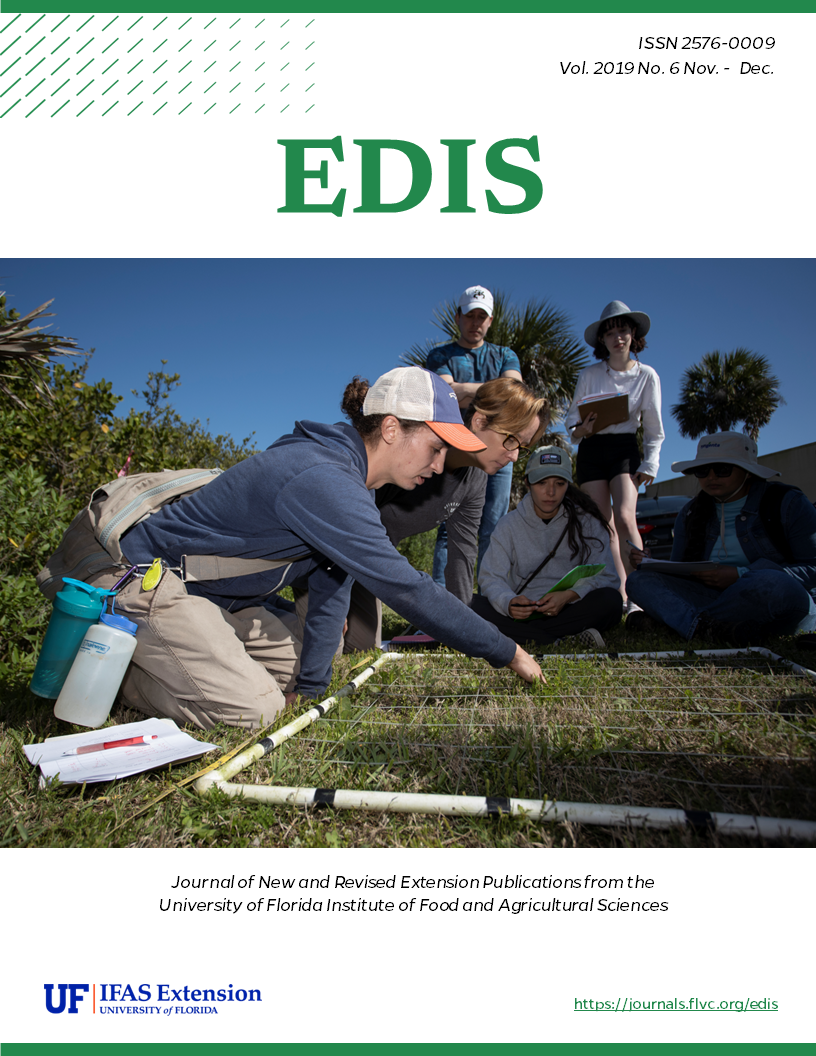Abstract
Florida is home to approximately 315 species of native wild bees. These bees rely on flowers for survival; their diets consist exclusively of pollen and nectar harvested from flowers. Recently reported declines in some bee species have heightened awareness of bee conservation across the United States and motivated efforts to increase floral resources for bees. This 7-page fact sheet written by Rachel E. Mallinger, Wayne Hobbs, Anne Yasalonis, and Gary Knox and published by the UF/IFAS Entomology and Nematology Department shows how gardeners and land managers can aid in conservation efforts by planting flowers for bees in home or community gardens.
http://edis.ifas.ufl.edu/IN1255
References
Biesmeijer, J. C., S. P. M. Roberts, M. Reemer, R. Ohlemüller, M. Edwards, T. Peeters, A. P. Schaffers, S. G. Potts, R. Kleukers, C. D. Thomas, J. Settele, and W. E. Kunin. 2006. "Parallel declines in pollinators and insect-pollinated plants in Britain and the Netherlands." Science 313 351-354. https://doi.org/10.1126/science.1127863
Blaauw, B. R., and R. Isaacs. 2014. "Larger patches of diverse floral resources increase insect pollinator density, diversity, and their pollination of native wildflowers." Basic and Applied Ecology 15 701-711. https://doi.org/10.1016/j.baae.2014.10.001
Burkle, L. A., J. C. Marlin, and T. M. Knight. 2013. "Plant-pollinator interactions over 120 years: Loss of species, co-occurrence, and function." Science 339 1611-1615. https://doi.org/10.1126/science.1232728
Colla, S. R., and L. Packer. 2008. "Evidence for decline in eastern North American bumblebees (Hymenoptera: Apidae), with special focus on Bombus affinis Cresson." Biodiversity Conservation 17 1379-1391. https://doi.org/10.1007/s10531-008-9340-5
Isaacs, R., J. Tuell, A. Fiedler, M. Gardiner, and D. Landis. 2009. "Maximizing arthropod-mediated ecosystem services in agricultural landscapes: The role of native plants." Frontiers in Ecology and the Environment 7 196-203. https://doi.org/10.1890/080035
Kearns, C. A., and D. M. Oliveras. 2009. "Environmental factors affecting bee diversity in urban and remote grassland plots in Boulder, Colorado." Journal of Insect Conservation 13 655-665. https://doi.org/10.1007/s10841-009-9215-4
Mader, E., M. Shepherd, M. Vaughan, S. Black, and G. LeBuhn. 2011. Attracting Native Pollinators. Storey Publishing, North Adams, Massachusetts, 1-385.
Mallinger, R. E., J. G. Franco, D. A. Prischmann-Voldseth, and J. R. Prasifka. 2019. "Annual cover crops for managed and wild bees: Optimal plant mixtures depend on pollinator enhancement goals." Agriculture, Ecosystems & Environment 273 107-116. https://doi.org/10.1016/j.agee.2018.12.006
Morandin, L. A., and C. Kremen. 2013. "Bee preference for native versus exotic plants in restored agricultural hedgerows." Restoration Ecology 21 26-32.
https://doi.org/10.1111/j.1526-100X.2012.00876.x
Pardee, G. L., and S. M. Philpott. 2014. "Native plants are the bee's knees: Local and landscape predictors of bee richness and abundance in backyard gardens." Urban Ecosyst 17 641-659. https://doi.org/10.1007/s11252-014-0349-0
Potts, S. G., J. C. Biesmeijer, C. Kremen, P. Neumann, O. Schweiger, and W. E. Kunin. 2010. Global pollinator declines: Trends, impacts and drivers. Trends in Ecology & Evolution 25 345-353. https://doi.org/10.1016/j.tree.2010.01.007
Ricketts, T. H., J. Regetz, I. Steffan-Dewenter, S. A. Cunningham, C. Kremen, A. Bogdanski, B. Gemmill-Herren, S. S. Greenleaf, A. M. Klein, M. M. Mayfield, L. A. Morandin, A. Ochieng, S. G. Potts, and B. F. Viana. 2008. "Landscape effects on crop pollination services: Are there general patterns?" Ecology Letters 11 499-515. https://doi.org/10.1111/j.1461-0248.2008.01157.x
Williams, N. M., K. L. Ward, N. Pope, R. Isaacs, J. Wilson, E. A. May, J. Ellis, J. Daniels, A. Pence, K. Ullmann, and J. Peters. 2015. "Native wildflower plantings support wild bee abundance and diversity in agricultural landscapes across the United States." Ecological Applications 25 2119-2131. https://doi.org/10.1890/14-1748.1
Unless otherwise specified, articles published in the EDIS journal after January 1, 2024 are licensed under a Creative Commons Attribution-NonCommercial-NoDerivs 4.0 International (CC BY-NC-ND 4.0) license.

